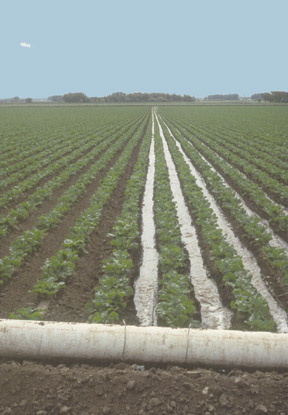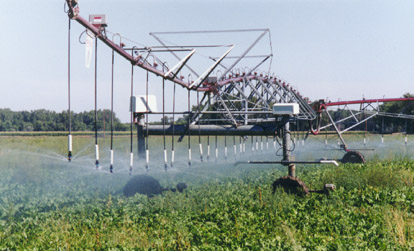By Lois Kerr
The main LYIP 80-mile long canal, with its 231 miles of laterals, 115 miles of drainage ditches and 800 original structures, made Yellowstone River water available to producers by 1910 for irrigation purposes. The smaller Buford-Trenton District in Williams County, completed in 1943, and the Savage District, completed in 1950, provided area growers with additional acres available for irrigation purposes. The irrigation projects supplied water through a main canal for growers in the area. However, growers, both in years past and today, worked very hard to get that water from the canals to their fields, and in the early years, each farm needed one person available strictly to handle the required irrigation duties.
 Richard Cayko, Fairview area beet grower, explains
that in the early years, most fields averaged 10 to 15 acres. Lasered land
technology did not exist, so ditches had to follow the high points in the
fields. "Growers put their ditches at the highest point in the field,"
Cayko says. "Workers would walk through the fields to change the direction
of the water's flow. Someone had to be there all the time to keep the
water moving."
Richard Cayko, Fairview area beet grower, explains
that in the early years, most fields averaged 10 to 15 acres. Lasered land
technology did not exist, so ditches had to follow the high points in the
fields. "Growers put their ditches at the highest point in the field,"
Cayko says. "Workers would walk through the fields to change the direction
of the water's flow. Someone had to be there all the time to keep the
water moving."
The person in charge of irrigation could only get a certain amount of water to flow in any one direction. Workers cut holes in the ditch bank at various places to allow water to come out into the field. These workers used canvases as dams and gates to control the flow of water. "Early irrigation was hard to control," Cayko states. "Fields would be over watered in some spots and under watered in others."
The introduction of lasered land leveling greatly improved flood irrigation methods. Fields got larger, and the land leveling allowed water to flow from one end of the field to the other, without constant supervision and without someone having to constantly manually move water through the field. "Producers generally make a two-to-one slope (for every 100 feet, the land has two inches of drop) or a three-to-one slope," Cayko remarks. "Three-to-one allows for faster irrigation."
With lasered land, fields needed a drain area, which allowed run-off water to return to the river.
Laser leveling also enabled growers to use siphon tubes. These siphon tubes allowed growers to water more rows using less water. Growers siphon water directly from the ditches to the rows that require watering. "Siphon tubes use less water, which means better water conservation, and at the same time, these tubes increase efficiency," Cayko comments.
 Lasered land also enabled growers to use gated pipes
for irrigation. Gated pipes, made from either aluminum or plastic, come in
20-foot sections which can be joined together to whatever length the
grower requires. Each section of pipe has gates in them, which can be
opened at each row of crop. Gated pipes eliminate the need for ditches,
which in turn eliminates ditch water evaporation. "Gated pipes are even
better for water conservation than the siphon method, and are easier to
work with," Cayko says. "Gated pipe allows a grower to water rows as
needed. Growers open gates on some rows, and shut gates for
others."
Lasered land also enabled growers to use gated pipes
for irrigation. Gated pipes, made from either aluminum or plastic, come in
20-foot sections which can be joined together to whatever length the
grower requires. Each section of pipe has gates in them, which can be
opened at each row of crop. Gated pipes eliminate the need for ditches,
which in turn eliminates ditch water evaporation. "Gated pipes are even
better for water conservation than the siphon method, and are easier to
work with," Cayko says. "Gated pipe allows a grower to water rows as
needed. Growers open gates on some rows, and shut gates for
others."
It generally takes about six hours for water to get from one end of the field to the other.
Cayko points out that gated pipes can't be used in all situations. "It all depends on the elevation of the source," he remarks. "Growers along the canal have a huge volume of water to draw from, but growers in areas with smaller ditches and those at the end of the canal don't have such a large volume of water and can't always take advantage of gated pipes."
In the valley, ditches are still the most prevalent means of irrigation. "Everyone has ditches," Cayko says. "Very few producers operate strictly with gated pipe."
Each grower has rights to a certain amount of water. The ditch riders in each area regulate the water, ensuring that all growers receive the water to which they are entitled.
 The
most efficient method of irrigation, but also one that cannot be used
everywhere, is the modern overhead sprinklers. Rocky Norby, Sidney area
beet grower with expansion acres in Culbertson and Poplar, uses pivots, or
sprinkler irrigation, on his Culbertson and Poplar land. "There have been
sprinkler systems since the '70s," Norby advises. "However, the original
sprinkler systems gave growers a lot of problems. The early pivots were
more trouble than they were worth, but in the past few years,
manufacturers have come out with some really good equipment. Sprinkler
systems have come a long way."
The
most efficient method of irrigation, but also one that cannot be used
everywhere, is the modern overhead sprinklers. Rocky Norby, Sidney area
beet grower with expansion acres in Culbertson and Poplar, uses pivots, or
sprinkler irrigation, on his Culbertson and Poplar land. "There have been
sprinkler systems since the '70s," Norby advises. "However, the original
sprinkler systems gave growers a lot of problems. The early pivots were
more trouble than they were worth, but in the past few years,
manufacturers have come out with some really good equipment. Sprinkler
systems have come a long way."
Norby feels the sprinkler systems are the most labor saving of all irrigation methods. Producers using flood irrigation meticulously laser level their land to get the proper slope. With pivots, water comes through drop tubes, so the land under sprinkler irrigation need not receive such careful preparation. This in itself lessens equipment wear and tear and saves time and energy.
As well, flood irrigation can over or under water a crop. Sprinkler irrigation allows a grower to adjust the amounts of water within the same field, depending on the varying soil types. This also saves time and energy costs. "Sprinklers conserve water," Norby says. "With most pivots, water costs are cheaper than a grower pays in the valley. Most pivots don't have much lift, so the cost of supplying water is often less with sprinkler systems."
He adds, "There's no run-off when watering with pivots, which helps make this system environmentally good."
Norby also points out that pivots can handle more acres than can flood irrigation. Most of the expansion acres have field sizes of 120 acres or more. Pivots come in various sizes, with some handling 125-130 acres, other handling 300 acres, and some pivots with the capacity to handle 500 acres. "You can set them up according to the size of the field," Norby says.
The newest, most sophisticated sprinkler systems come with remote controls. "Growers can operate these systems by telephone, or with a home computer," Norby comments. "The systems come with computer programs that keep the grower informed of all aspects of the watering system."
Norby feels sprinkler systems will dominate irrigation in the future. "Sprinklers outperform flood irrigation," he says. "If pivots were as far advanced 30 years ago as they are today, we'd all have pivots."
No one way works best for everyone. Each operation is different, soil types differ, sizes of fields differ. Growers use the method or methods that best suits their particular operation. However, no matter which method or methods growers choose to use for irrigation, one fact remains. Without irrigation, the valley would not have attracted the sugar refinery 75 years ago, and valley growers would likely not have the option of growing sugar beets as an integral part of their rotation.
Today, the Lower Yellowstone Irrigation project irrigates 54,500 acres and serves approximately 500 farm units. The Savage unit has a 7.8-mile main canal, 4.6 miles of lateral ditches, irrigates 2300 acres, and serves 22 farm units. The Buford-Trenton irrigation district operates with a 21-mile main canal, 32 miles of laterals, 10 miles of drainage ditches, irrigates about 10,000 acres, and serves approximately 100 farm units. Flood irrigation dominates in all three of these districts, but more growers are turning to sprinkler systems, and most of the expansion acres use the sprinkler method of irrigation.